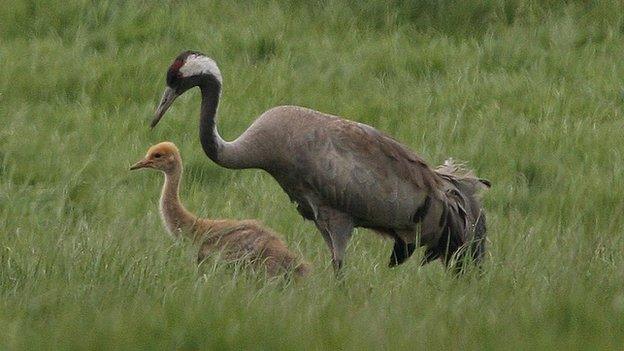Crane chicks bred in Scotland 'first since Middle Ages'
- Published

A pair of cranes in the north-east of the country has successfully reared two chicks
Conservationists have said they are "stunned" that common cranes have successfully bred in Scotland for the first time since the Middle Ages.
Two chicks have been raised in the north-east of the country in the past two years, RSPB Scotland has said.
The birds typically spend their summers in northern Europe and migrate to France and Spain for winter.
They were once common in the UK but died out in the 16th Century.
Cranes are known for their graceful tall stature and loud mating calls.
The bird was a popular royal meal in the Middle Ages but the species disappeared mainly because of hunting and loss of habitat.
Breeding displays
Since the 1970s a group of cranes have re-established a small population in Norfolk with 17 pairs breeding, but the two chicks born in Scotland are the first confirmed north of the border for hundreds of years.
A crane can grow to 1.3m (4.2ft) tall, with a wingspan of 2.4m (7.8ft). Their elegant breeding displays, which include dancing and ruffling feathers, are popular with bird spotters.
Cranes have been seen in the last few years at RSPB's Loch of Strathbeg nature reserve, near Fraserburgh, while travelling back to their breeding spots in northern Europe.
The bird charity is not disclosing the exact location of the nest site to minimise the risk of disruption.
The species favours large wetland areas such as lowland peat bogs and feeds on small insects, plants and grains.
Stuart Housden, director of RSPB Scotland, said: "We are stunned and delighted to see that common cranes have bred successfully in Scotland.
"These charming, elegant birds have a strong place in our myths and history and are a delight to see, particularly during the breeding season with their dancing displays.
"They undertake regular migrations and small numbers have turned up on the east coast of Scotland in recent years, raising hopes of a re-colonisation. Last year a pair reared one chick, followed by a second chick in 2013."
He added: "We have been working with local farmers, landowners and the community to monitor these fantastic birds.
"Despite their size and flamboyant breeding displays, cranes are secretive birds and are very sensitive to disturbance, and we ask that they be given space and peace so they may establish a breeding population in Scotland."
- Published30 August 2013
- Published20 May 2013
- Published24 September 2012
- Published15 May 2012